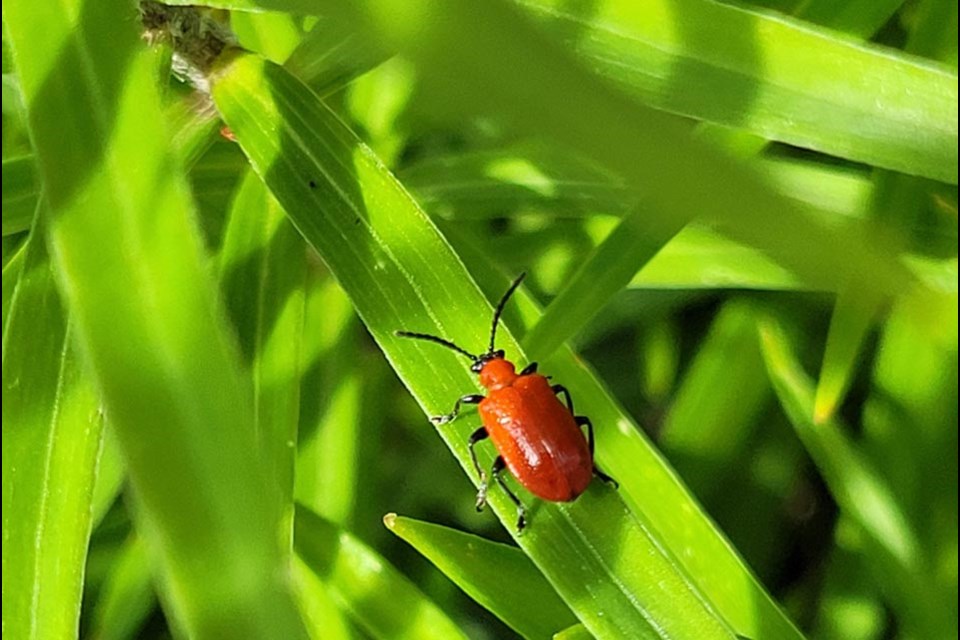My fight with the dreaded lily beetle began early this year, even before the actual Martagon and Asiatic lilies put in an appearance. In my garden they are attracted to the early blooming fritillary. This year, they had decimated my checkered lily, Fritillaria meleagris, before I caught them in time to save a white fritillary variety that has more robust foliage. As the years go on, I have gotten braver, picking them off with bare hands and crushing them underfoot. From mid-May to early June, I picked an average of 20 adults a day, mostly around my emerging Martagon lilies, which broke ground usually already covered with the now familiar red creatures. Disturbing the soil around the lilies every morning usually sent several of them scurrying, mostly unsuccessfully, for safety.
There was a break in activity around the beginning of June, with only the occasional sighting of the adult beetles for the next few weeks. This lulled me into thinking that the problem was over for the year, alas, it was not to be. Holes started reappearing in Martagon and Asiatic lily foliage as the grubs hatched out of eggs laid on the underside of the leaves and voraciously devoured their garden salad or lily leaves.
The scarlet lily beetle, red lily beetle or lily leaf beetle (Lilioceris lilii) first arrived in eastern Canada through the importation of plant bulbs in the early 1940s and has been slowly making its way west. It is unmistakable: bright red, with a black head and large black eyes, 8-10 mm in length, oval in shape. The adults overwinter in the soil or under leaf litter, often near the plants they feed on. They emerge in late April or early May and soon settle down to feed and mate.
The female lays 2 to 16 reddish-orange eggs on the underside of lily leaves in an irregular line. The eggs hatch within 8-10 days. The first larvae that hatch are black, while later larvae are yellowish-white with a black head. The lily beetle larva deposits its feces on its back (this is called a “fecal shield”) as a protection against the hot sun and to disguise itself from predators. The larvae feed for about 3 weeks and can wreak havoc, capable of devouring entire lily plants. Once mature, the larvae enter the soil, change to an orange colour, and pupate within a cocoon. In three weeks, they emerge as beetles and continue to feed on lilies until cold weather sets in, when they head for the soil to overwinter.
Lily beetles have no natural enemies in North America. In Europe and their native Asia, they are controlled by a parasitic wasp, (Tetrastichus setifer) which lays its eggs in lily beetle larvae and the developing wasp larvae consumes the beetle larvae, effectively killing them. While these wasps have been released near Olds College and Calgary in Alberta and in Winnipeg, Manitoba, where they have successfully overwintered and seem to control beetle populations, no data is available for Saskatchewan.
As a natural gardener who does not use diatomaceous earth or pesticides, because they can be detrimental to other insects, my only option is to continue to be vigilant and use my preferred dispatch method. Either picking them manually or flicking them into a jar of soapy water. As a deterrent, I have stopped planting Asiatic lilies and concentrate on the survival of my existing Martagon lilies. My advice to gardeners is to plant lilies in spots that are easily accessible to you, near pathways, so you can inspect them daily throughout the season.
As an end note, last year in September, I noted some damage on two of my hostas, and thought that now, besides thrips and aphids, I would have to start looking for snails in my somewhat dry, shaded garden. Inspection of the underside of the leaves revealed that in the absence of available lily fodder, the evil lily beetle had resorted to a hosta buffet.
This column is provided courtesy of the Saskatchewan Perennial Society (SPS; [email protected]). Check our website (www.saskperennial.ca) or Facebook page (www.facebook.com/saskperennial) for a list of upcoming gardening events.




